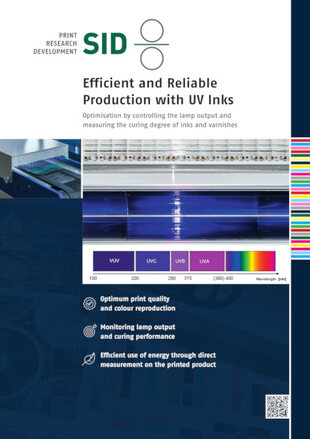Dosage Measurement for UV-LEDs
Efficient and Reliable Production with UV Inks

Optimisation of the process parameters by controlling the lamp output including UV LEDs and measuring the curing degree of inks and varnishes
What are the benefits of measuring UV LEDs?
- Quality: Optimum print quality and colour reproduction
- Efficiency: Monitoring lamp output and curing performance
- Sustainability: Efficient use of energy through direct measurement on the printed product
Optimisation of the Process Parameters
The curing of printing inks, inkjet inks and coatings using UV irradiation is an efficient technology that can be used to process a wide range of substrates and achieve a high degree of finishing.
We can determine the optimum lamp settings for you and identify when cleaning or early maintenance of the lamp modules is necessary.
With regular testing, the condition of the UV LEDs can be continuously monitored and a decline in performance due to aging or contamination can be recognised quickly.
The goal is not only to ensure reliable curing of the inks and varnishes but also to optimise energy consumption.
Dosage Measurement Including UV-LEDs

A dosage measurement is required to assess the irradiation amount that actually hits the printed product and triggers the curing process. The commercially available measuring strips for measuring the dosage of mercury vapour lamps cannot be used for UV LEDs, as they only absorb in the range from 200 to 350 nm. The spectrum emitted by LEDs with the wavelengths of 365 / 375 / 385 / 395 nm cannot be recorded with these strips. For this reason, SID has developed new measuring strips specifically for this range.
The strips are fixed on a sheet in the feeder pile and evaluated after passing through the printing press to assess the colour change caused by the UV irradiation.
This approach offers several advantages, as the irradiation reaching the print under real production conditions can be measured. Fluctuations due to substrate distortions or shadowing caused by moving machine parts can be detected in this way. This allows us to check only whether the level of UV irradiation is sufficient to cure the inks and coatings used. Detailed analyses can also be carried out on the homogeneity of the UV irradiation over the entire sheet surface and on the influence of different printing conditions such as substrates and printing speeds.
We lighten your load and show you how it’s done.
For more information
PDF-Download.
Dosage Measurement for UV-LEDs
Efficient and Reliable Production with UV Inks
Your contact partners:
Dipl.-Ing. Beatrix Genest
Tel: +49 341 25942-28
Dipl.-Ing. (FH) Carolin Sommerer
Tel: +49 341 25942-23


